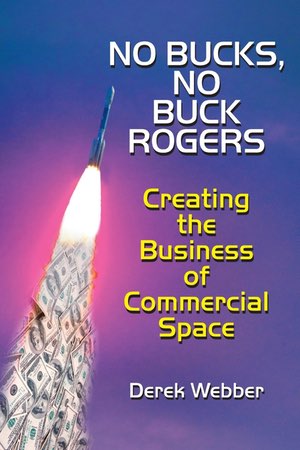Review: No Bucks, No Buck Rogersby Jeff Foust
|
| He argues that the traditional businesses have reached their limits: growth in the relatively mature market of satellite communications has slowed, while government initiatives are stymied by budgets unlikely to return to the levels seen in the early Space Race. |
This week, though, will largely belong to the present-day space business. The Satellite 2017 conference, starting Monday in Washington, will bring in the satellite operators, manufacturers, and other suppliers that make up the vast majority of the industry, which generated more than $200 billion in revenue in 2015.
Even here, though, there’s change in the air: barely 12 hours after Elon Musk revealed SpaceX’s plans for a commercial Moon trip last week, venerable satellite operator Intelsat announced it had reached a deal to merge with up-and-coming broadband satellite constellation company OneWeb, with Japan’s SoftBank putting in $1.7 billion to make the deal happen. That came days after DigitalGlobe, the largest commercial satellite remote sensing company, announced it agreed to be acquired by Canada’s MacDonald, Dettwiler and Associates for $2.4 billion in cash and stock.
It’s this shift in the space business—from old companies and markets to new ones—that Derek Webber examines in No Bucks, No Buck Rogers. His career spans both: he worked for companies like Inmarsat to support the procurement and launch of its satellites. He later focused on emerging markets, like space tourism, leading the most detailed market study to date, and since, on the demand for suborbital and orbital personal spaceflight. (I worked with him on that 15 years ago at Futron Corporation, part of a much broader market study delivered to NASA for its short-lived Space Launch Initiative.)
Webber reviews both traditional and new space businesses in his book. He argues that the traditional businesses have reached their limits: growth in the relatively mature market of satellite communications has slowed, while government initiatives are stymied by budgets unlikely to return to the levels seen in the early Space Race. What’s needed for the space industry to grow is for it to transition to new markets. Space tourism, he believes, can support that transition, enabling the development of other markets.
| It’s long been argued that people represent a mass market for launches in a field where the number of satellites per year is usually measured in the dozens. Yet that theoretical logic is still just that—theoretical. |
This is a familiar argument, but one that Webber logically lays out for those unfamiliar with the idea. Even those who are already familiar with that central argument, and other details about the industry, will appreciate Webber’s anecdotes from a half-century in the business. That includes his description of all the work that goes into a satellite procurement process (illustrated, from the days before email and PDFs, by a photo of the delivery of a truck full of boxes representing one company’s response to an Inmarsat request for proposals.) He also recalls discussions in the 1980s about potential use of the Proton rocket at a time when Soviet officials were still unfamiliar with the basics of sales and marketing.
There is, of course, an underlying logic to the book’s argument about the role space tourism can play in growing the space industry: it’s long been argued that people represent a mass market for launches in a field where the number of satellites per year is usually measured in the dozens. Yet that theoretical logic is still just that—theoretical—nearly 15 years after that Futron/Zogby forecast of space tourism demand was published. Suborbital space tourism in particular has developed far more slowly than envisioned in the heyday of the Ansari X PRIZE, an issue that he acknowledges in the book but doesn’t examine the reasons why. Despite the delays, he remains optimistic that vehicles like Virgin Galactic’s SpaceShipTwo can double the number of people who have flown in space (currently less than 600) within a year.
Webber concludes his book with a look at some of the markets that can be opened up with that transition enabled by space tourism, including asteroid mining and lunar bases. Lunar efforts, it seems, don’t appear to be waiting on space tourism, given recent events and other efforts, like the Google Lunar X PRIZE (for which Webber is one of the judges.) This week, those old and new markets will intermingle: one of the highlights of the Satellite 2017 conference this week is a talk by Blue Origin founder Jeff Bezos, who will likely discuss how his company’s efforts will help the established space industry. Even as we wait for space tourism to take off, the transition described in No Bucks, No Buck Rogers is already taking place.
